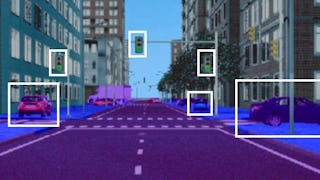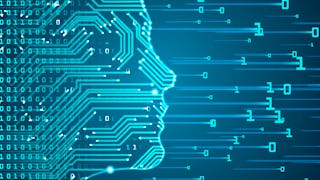Unlock the power of deep learning to transform visual data into actionable insights. This hands-on course guides you through the foundational and advanced techniques that drive modern computer vision applications—from image classification to generative modeling.



Deep Learning for Computer Vision
Ce cours fait partie de Spécialisation Computer Vision

Instructeur : Tom Yeh
Inclus avec 
Expérience recommandée
Ce que vous apprendrez
Improve model performance and training stability using multilayer perceptrons (MLPs) and applying normalization techniques.
Implement autoencoders for unsupervised feature learning and design Generative Adversarial Networks (GANs) to generate synthetic images.
Train convolutional neural networks (CNNs) for image classification tasks, understanding how layers extract spatial features from visual data.
Apply advanced architectures like ResNet for deep image recognition and U-Net for image segmentation.
Compétences que vous acquerrez
- Catégorie : Unsupervised Learning
Détails à connaître

Ajouter à votre profil LinkedIn
août 2025
21 devoirs
Découvrez comment les employés des entreprises prestigieuses maîtrisent des compétences recherchées

Élaborez votre expertise du sujet
- Apprenez de nouveaux concepts auprès d'experts du secteur
- Acquérez une compréhension de base d'un sujet ou d'un outil
- Développez des compétences professionnelles avec des projets pratiques
- Obtenez un certificat professionnel partageable

Il y a 4 modules dans ce cours
Welcome to Deep Learning for Computer Vision, the second course in the Computer Vision specialization. In this first module, you'll be introduced to the principles behind neural networks and their use in visual recognition tasks. You'll begin by learning the basic building blocks—neurons, weights, biases—and progress toward constructing simple multi-layer perceptrons. Then, you'll discover key activation concepts like batch processing and graph-matrix conversions. Finally, you will visualize neural networks with an emphasis on classification tasks.
Inclus
19 vidéos6 lectures6 devoirs
In this module, you’ll explore two powerful architectures in deep learning: autoencoders and generative adversarial networks (GANs). You’ll begin by learning how autoencoders compress and reconstruct data using encoder-decoder structures, and how reconstruction loss is minimized through backpropagation and gradient descent. You’ll then examine the role of loss functions and optimization techniques in training these models. In the second half of the module, you’ll dive into GANs, where a generator and discriminator compete to produce realistic synthetic data. You’ll study how adversarial training works, how binary cross-entropy loss is applied, and how GANs are used to model complex data distributions. By the end of this module, you’ll be able to implement and evaluate both autoencoders and GANs for representation learning and data generation.
Inclus
13 vidéos2 lectures5 devoirs
In this module, you’ll learn how convolutional neural networks extract features from images and perform classification. You’ll begin by building a tiny CNN by hand and in Excel, exploring convolution, max-pooling, and fully connected layers. Then, you’ll scale up to larger CNN architectures and examine how they process data through multiple convolution and pooling stages. You’ll also study how categorical cross-entropy loss and gradients are computed for training. Finally, you’ll walk through backpropagation across all CNN layers to understand how learning occurs.
Inclus
16 vidéos1 lecture5 devoirs
In this module, you’ll explore two influential deep learning architectures: ResNet and U-Net. You’ll begin by learning how ResNet uses skip connections and residual learning to enable the training of very deep networks, addressing challenges like vanishing and exploding gradients. You’ll examine how residual blocks preserve information and support higher-order logic across layers. Then, you’ll shift to U-Net, a powerful architecture for image segmentation, and study its encoder-decoder structure, skip connections, and upsampling techniques like transposed convolution. By the end of this module, you’ll understand how both architectures enhance learning efficiency and performance in complex vision tasks.
Inclus
17 vidéos2 lectures5 devoirs
Obtenez un certificat professionnel
Ajoutez ce titre à votre profil LinkedIn, à votre curriculum vitae ou à votre CV. Partagez-le sur les médias sociaux et dans votre évaluation des performances.
Instructeur

Offert par
En savoir plus sur Algorithms
 Statut : Prévisualisation
Statut : PrévisualisationUniversity of Colorado Boulder
 Statut : Essai gratuit
Statut : Essai gratuitMathWorks
 Statut : Essai gratuit
Statut : Essai gratuitUniversity of Colorado Boulder
 Statut : Essai gratuit
Statut : Essai gratuit
Pour quelles raisons les étudiants sur Coursera nous choisissent-ils pour leur carrière ?





Ouvrez de nouvelles portes avec Coursera Plus
Accès illimité à 10,000+ cours de niveau international, projets pratiques et programmes de certification prêts à l'emploi - tous inclus dans votre abonnement.
Faites progresser votre carrière avec un diplôme en ligne
Obtenez un diplôme auprès d’universités de renommée mondiale - 100 % en ligne
Rejoignez plus de 3 400 entreprises mondiales qui ont choisi Coursera pour les affaires
Améliorez les compétences de vos employés pour exceller dans l’économie numérique
Foire Aux Questions
To access the course materials, assignments and to earn a Certificate, you will need to purchase the Certificate experience when you enroll in a course. You can try a Free Trial instead, or apply for Financial Aid. The course may offer 'Full Course, No Certificate' instead. This option lets you see all course materials, submit required assessments, and get a final grade. This also means that you will not be able to purchase a Certificate experience.
When you enroll in the course, you get access to all of the courses in the Specialization, and you earn a certificate when you complete the work. Your electronic Certificate will be added to your Accomplishments page - from there, you can print your Certificate or add it to your LinkedIn profile.
If you subscribed, you get a 7-day free trial during which you can cancel at no penalty. After that, we don’t give refunds, but you can cancel your subscription at any time. See our full refund policy.
Plus de questions
Aide financière disponible,

